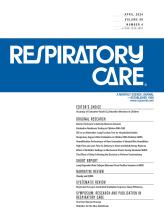This article requires a subscription to view the full text. If you have a subscription you may use the login form below to view the article. Access to this article can also be purchased.
Abstract
BACKGROUND: In recent years, mechanical power (MP) has emerged as an important concept that can significantly impact outcomes from mechanical ventilation. Several individual components of ventilatory support such as tidal volume (VT), breathing frequency, and PEEP have been shown to contribute to the extent of MP delivered from a mechanical ventilator to patients in respiratory distress/failure. The aim of this study was to identify which common individual setting of mechanical ventilation is more efficient in maintaining safe and protective levels of MP using different modes of ventilation in simulated subjects with ARDS.
METHODS: We used an interactive mathematical model of ventilator output during volume control ventilation (VCV) with either constant inspiratory flow (VCV-CF) or descending ramp inspiratory flow, as well as pressure control ventilation (PCV). MP values were determined for simulated subjects with mild, moderate, and severe ARDS; and whenever MP > 17 J/min, VT, breathing frequency, or PEEP was manipulated independently to bring back MP to ≤ 17 J/min. Finally, the optimum VT-breathing frequency combinations for MP = 17 J/min were determined with all 3 modes of ventilation.
RESULTS: VCV-CF always resulted in the lowest MPs while PCV resulted in highest MPs. Reductions in VT were the most efficient for maintaining safer and protective MP. At targeted MPs of 17 J/min and maximized minute ventilation, the optimum VT-breathing frequency combinations were 250–350 mL for VT and 32–35 breaths/min for breathing frequency in mild ARDS, 200–350 mL for VT and 34–40 breaths/min for breathing frequency in moderate ARDS, and 200–300 mL for VT and 37–45 breaths/min for breathing frequency for severe ARDS.
CONCLUSIONS: VCV-CF resulted in the lowest MP. VT was the most efficient for maintaining safe and protective MP in a mathematical simulation of subjects with ARDS. In the context of maintaining low and safe MPs, ventilatory strategies with lower-than-normal VT and higher-than-normal breathing frequency will need to be implemented in patients with ARDS.
Footnotes
- Correspondence: Robert L Chatburn MHHS RRT RRT-NPS FAARC. E-mail: chatbur{at}ccf.org
Mr van der Staay is an employee of IMT Information Management Technology. Mr Chatburn discloses relationships with IngMar Medical, Inovytec Medical Solutions, Aires Medical, Ventis Medical, Stimdia, and University of Cincinnati. The remaining authors have disclosed no conflicts of interest.
The study was performed at American University of Beirut, Beirut, Lebanon.
- Copyright © 2024 by Daedalus Enterprises
Pay Per Article - You may access this article (from the computer you are currently using) for 1 day for US$30.00
Regain Access - You can regain access to a recent Pay per Article purchase if your access period has not yet expired.







